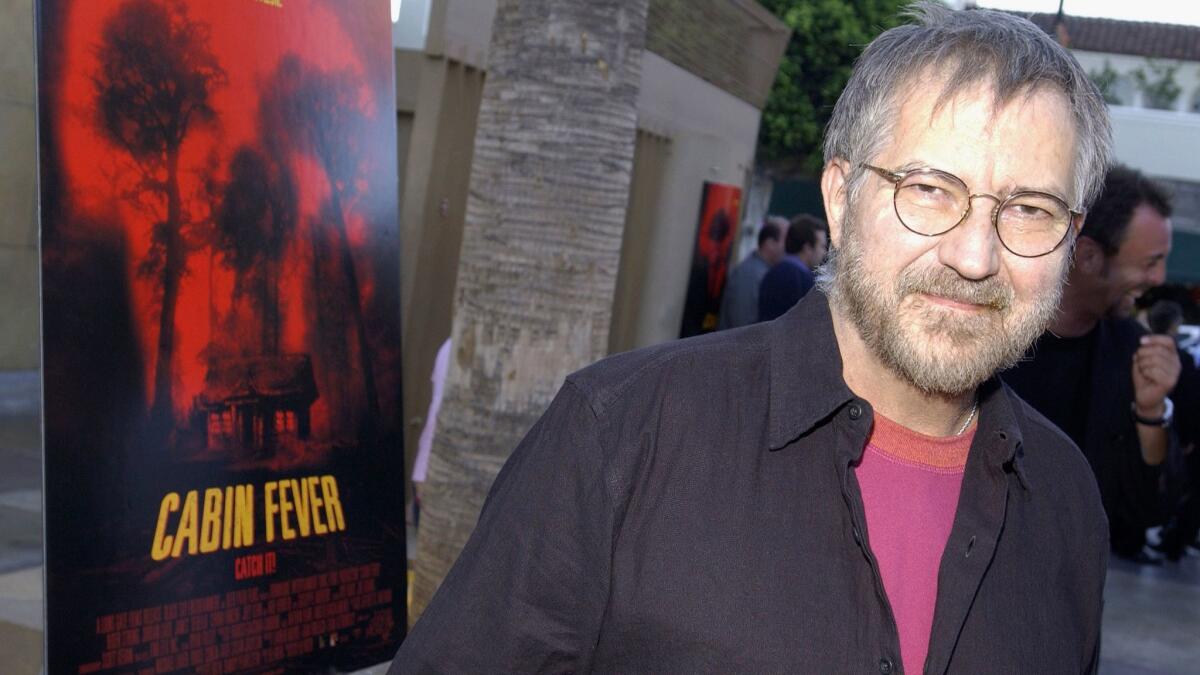From the Archives: ‘Texas Chainsaw’ and ‘Poltergeist’ director Tobe Hooper looks for a more psychological scare these days

- Share via
Director Tobe Hooper, who guided such films as “Texas Chainsaw Massacre” and “Poltergeist,” has died. Daniel Cerone spoke to the influential director about a new project in 1990 and a possible turn in his career.
Tobe Hooper flipped a switch and a 10-foot projection screen smoothly rolled down from the ceiling in his Benedict Canyon home. He pulled from his stockpile of videocassettes a 4-year-old episode he directed for Steven Spielberg’s “Amazing Stories” TV series and inserted it into a tape machine.
In moments, a six-foot image of “Weird” Al Yankovic dressed as a green alien cabbage man materialized on screen. In a way, Weird Al was one of the more normal sights in Hooper’s home.
The horror director — whose latest work can be seen Wednesday at 9 p.m. on USA cable in a new film called “I’m Dangerous Tonight,” starring Anthony Perkins and Madchen Amick — keeps strange mementos from his pet projects.
Enshrined in a glass case is a meat hook from “The Texas Chainsaw Massacre” (he says Spielberg has the other one). The dismembered hitchhiker corpse from the same movie sits in his living room. Then there’s the steel mallet from “The Texas Chainsaw Massacre II,” a staircase banister from “Salem’s Lot” and a ceramic doll used in “Freddy’s Nightmares.”
The props, most grotesque and out of place in the quiet suburban house, are tokens of an unassuming man whose paramour has always been film fantasy. His supernatural USA movie stars Perkins as an archeology professor who helps one of his students, Amick (Shelley of “Twin Peaks”), when she succumbs to the deadly powers of an ancient Aztec cloak.
I always figured I would be there one day making movies, because really there wasn’t anything else I could do. That’s all I thought about.
— Tobe Hooper
“I went to the movies every day, sometimes twice a day, growing up,” said Hooper, 47, who was raised in Austin and Dallas. Wearing a cap, T-shirt, jeans and shoes — all solid black — Hooper sat in his living room holding a stubby, unlighted cigar.
“I saw everything,” he continued. “I always figured I would be there one day making movies, because really there wasn’t anything else I could do. That’s all I thought about. That’s all I dreamed about. I would talk my teachers at school into letting me turn in an 8-millimeter film instead of written projects.”
When he was 25, the former University of Texas film student abandoned documentaries and TV commercials to make a feature film called “Eggshells.”
“We shot for about nine months,” Hooper said, his soft-spoken words a contrast to his gravel-rock voice. “It was partly shot off a script written on a napkin and partly improvisational shooting.”
He paused and tried to light his cigar. It wouldn’t light. He gave up and just held the cigar in his hand.
“It was a film about hippies at the end of the Vietnam War,” he continued, “and they were living in a commune house that was also inhabited by this thing we called a crypto-embryonic-hyper-electric presence.”
Hooper said that the low-low-budget “Eggshells” played in only about 50 theaters, but the horror element was a hit. “I learned what I had to do to get attention,” he said. “I was in Texas, 2,000 miles away from the center of activity in Los Angeles. I had to have a gimmick to get into any kind of stream, let alone the mainstream.”
So Hooper co-wrote a script with Kim Henkel inspired by bloody events in Wisconsin, raised $155,000 from a consortium of good-ol’-boy businessmen and politicians in Austin and shot “Chainsaw Massacre” on 16mm film in the summer of 1973.
The exploitation film, about a cannibalistic family that gives new meaning to roadside kill, first went largely unnoticed, then became a cult classic, then spawned a hailstorm of imitations and now is hailed by some as a groundbreaking classic.
When “Chainsaw Massacre” was released, film critic Roger Ebert wrote, “It’s without any apparent purpose, unless the creation of disgust and fright is a purpose.”
Time and again, I’ve not gone as far as I could have gone, and I’ve regretted it. I’m not talking about visceral business, but psychological. Sheer scare.
— Tobe Hooper
“Oh yeah, I was trying to scare (people), shock them, sure,” Hooper said. “I still do. Time and again, I’ve not gone as far as I could have gone, and I’ve regretted it. I’m not talking about visceral business, but psychological. Sheer scare. Over the course of my career I’ve really searched for the proper balance.”
Hooper is now developing two new films and a TV series, and hopes to shed the scaly reputation of a horror director.
“I’ve been trying for many years to break out of that mold,” Hooper said. “The face of horror is changing. I think we’re about saturated with graphics. I definitely think it’s taking a turn toward the psychological and emotional.”
“Oh no, no. I don’t think so,” Hooper responded when asked if he planned to retire one day soon. He shook his head and smiled as if he just heard an inside joke. “There’s nothing else I want to do. This is all I’ve ever wanted to do. It’s like play for me. Orson Welles said it best — making a movie is the best electric train a kid ever had.”
See the most-read stories in Entertainment this hour >> »
More to Read
Only good movies
Get the Indie Focus newsletter, Mark Olsen's weekly guide to the world of cinema.
You may occasionally receive promotional content from the Los Angeles Times.








